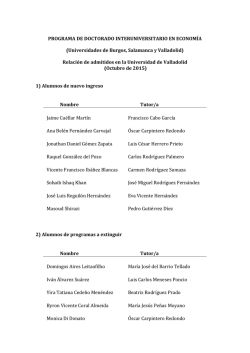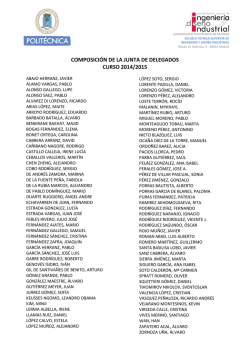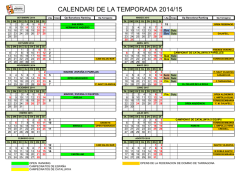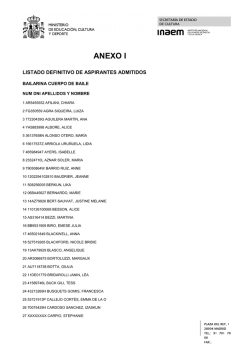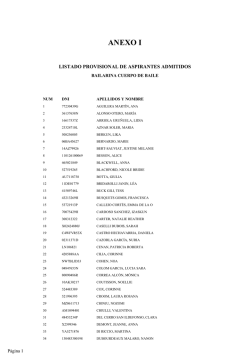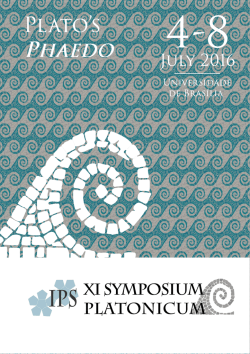
programa
THURSDAY 24th SEPTEMBER 2015 8:30-9:00 9:00-9:30 9:30-10:30 Registration Welcome Keynote speech. Taphonomy of animal bones: When humans feed on small prey. Lluís Lloveras 10:30-11:00 COFFEE BREAK* 11:00-13:00 Session 1. Innovate or die: new methodological advances in zooarchaeology (Chair: Anna Rufà) 11:00 - Assigning sex to bird bones using sex genotyping: A pilot study. Ged Poland 11.20 -Diet and management of ancient sheep and goats: the potential of dental microwear. Lucy Lawrence 11:40 - Interpreting the Schöningen 13II-4 butchery sequence using the Harris Matrix. Aritza Villaluenga, Sina Lehnig, Jarod M. Hutson, Alejandro García-Moreno, Elaine Turner, Sabine Gaudzinski-Windheuser 12:00 - Relevance of the screen in the zooarchaeological record of historical periods. The site of La Maria (Seville) as a test-case study. Francisco Javier Luengo, Araceli Rodríguez, Álvaro Fernández 12:20 - What about bunnies? Identifying and utilizing often found and seldom used small mammal fauna data. Karin Scott 12:40 - The fatter the flea the leaner the dog – Finding out function by the anatomical characteristics of archaeological dog remains. Annamária Bárány 13:00-15:00 15:00-17:00 LUNCH TIME Session 2. What to eat? Variability in the subsistence and occupational strategies from the Middle Pleistocene to the Holocene (Chair: Maria Joana Gabucio, Leopoldo J. Pérez) 15:00 - Overview on Schöningen 13 II-4 “Spear Horizon”: Zooarchaeology, Taphonomy, GIS and much more… Aritza Villaluenga, Jarod M. Hutson, Alejandro García-Moreno, Elaine Turner, Sabine Gaudzinski-Windheuser 15:20 - Reconstruction of Neanderthals occupational patterns in the MIS 3: bones refitting at Abric Romaní and Riparo Tagliente. Marta Modolo, Jordi Rosell, Ursula Thun Hohenstein 15:40 - Subsistence patterns during the Lower Magdalenian in Cantabrian Spain (ca. 17000-14000 BP; ca. 20000-17000 cal BP): terrestrial mammal exploitation. Rodrigo Portero 16:00 - The exploitation of animal resources in the Calcolithic site of Porto Torrão (Alentejo – Portugal) – Preliminary data. Vera Pereira 16:20 - Study of socio-economic and consumption strategies during the Middle and Final Bronze Age in Majorca (Balearic Islands): the village of Els Closos de Ca’n Gaià. Lua Valenzuela, Sílvia Valenzuela-Lamas 16:40 - New data about the faunal assemblage of Castro de Achadizo (Cabo de Cruz, Galicia). Raquel Pérez, Palmira Saladié, Carlos Fernández, Cristina Seoane, Estevo Amado, Alba Antía Rodríguez 17:00-18:30 IPHES LAB VISIT FRIDAY 25th SEPTEMBER 2015 9:00-11:00 Session 3. Sharing the space: hominids and other animals within the environment (Chair: Antonio Rodríguez-Hidalgo) 9:00 - Changing competition dynamics at the Barranc de la Boella (late Early Pleistocene): palaeoecological and behavioral implications. Antonio Pineda, Palmira Saladié, Rosa Huguet, Isabel Cáceres, Josep Vallverdú 9:20 - Bird bones from Gruta da Figueira Brava (Arrábida, Portugal). Mariana Nabais, Carlos Pimenta 9:40 - Together but not mixed: a field approximation for distinguish accumulations of leporids generated by humans and raptors in a Middle Palaeolithic context. The case of El Salt (Alicante, Spain). Leopoldo J. Pérez, Cristo M. Hernández, Jorge Machado, Carolina Mallol 10:00 - Insular zooarchaeology in the Pleistocene-Holocene transition: a Philippine case. Janine Ochoa 10:20 - Predation in human evolution: Hominins as carnivore prey? Edgard Camarós, Marián Cueto 10:40-11:10 COFFEE BREAK* 11:10-13:00 Session 4. Wild or domesticated: coexistence and exploitation of domestic and wild animals in the past (Chair: Patricia Martín, Àngel Blanco) 11:10 - The role of Aşıklı Höyük in the Beginning of Animal Domestication in Central Anatolia. Abu Bakar Siddiq 11:30 - Passing your time in the hilly flanks away: preliminary investigations into the animal economy of Tepe Marani, Iraqi Kurdistan. Elizabeth Farebrother 11:50 - New insights into pig differentiation and Tell Halula as a case study. Roger Alcàntara 12:10 - In the kitchen of Człuchów governor. Study on XVIth, XVIIth and XVIIIth PolishLithuanian Commonwealth cuisine. Kamil Niemczak 13:00-15:00 LUNCH TIME 15:00-16:30 Session 5. Special animal treatment in archaeological contexts (Chair: Carlos Sánchez-Hernández, Antonio Pineda) 15:00 -The chelonians in the Iberian archaeological record and the importance of the ensemble of Camino de las Yeseras (Calcolithic of Madrid, Spain). Iratxe Boneta, Adán Pérez-García, Corina Liesau 15:20 - Some observations on the features of animals presented in the tribute scenes of the Pharaonic Egypt. Kamila Braulińska 15:50 - Llama (Llama glama) and Alpaca (Vicugna pacos) as a main victim of Inca religious practices. Katarzyna Marciniak 16:10 - Preliminary results on Late Roman animal bone deposit from Vermeulenstraat in Tongeren (Belgium). Emmy Nijssen 16:30-17:00 Discussion and closing remarks 17:00-18:30 APERITIF/DRINKS SATURDAY 26th SEPTEMBER 2015 9:30-10:00 Reception at the City Council of Tarragona 10:00-13:30 Guided tour around Roman Tarragona POSTER EXHIBITION 01 Deer Parks and Recreation. Zooarchaeological evidence from the Earls of Arundel hunting lodge in Downley (West Sussex, UK). Mariana Nabais, Nicole Barber, Mark Roberts 02 Hunting, breeding and environmental changes-petroglyphs from Tien Shan range. Pawel Janik, Dominika Kossowska 03 Approximation to animal husbandry of enclosures A16 and A17 of the site of l'Assut (Tivenys, Tarragona, Spain). Sergio Jiménez Manchón, Isabel Cáceres, Jordi Diloli Fons 04 Shedding light on dog domestication process: a new methodological approach. Valentina Catagnano 05 New archaeozoological data for the Late Antiquity in the northern Iberia Peninsula: El Castillón (Santa Eulalia de Tábara, Zamora). Rodrigo Portero Hernández, E. Álvarez-Fernández, J. C. Sastre Blanco, P. Fuentes Melgar, D. Franganillo Rodríguez 06 Biodiversity and Animal Management Strategies in Wetland Environments durnig the Middle Holocene: a Comparison between the Alpine and the Mediterranean Areas. Vanessa Navarrete 07 Management and exploitation of livestockand wild faunas from the Early Bronze age levels of Vallone Inferno (PA) and Case Bastione (EN) sites. Giovanni Di Simone, Daria Petruso, Patricia Martín Rodríguez 08 A working system for the recording and analysis of processing marks on bones. Anita Cornwell, Albert Fischer 09 New results of interaction between Homo sapiens, carnivores and megafauna in the Pampean region (Argentina) during the first American peopling. Karina Vanesa Chichkoyan 10 Breaking the bones. Fresh breakage on rabbit bones: an experimental approach. Carolina Aparicio, Anna Rufà, Ruth Blasco 11 Cervus elaphus & Equus ferus. Are they a good proxy to infer seasionality at Teixoneres cave? Carlos Sánchez-Hernández, Florent Rivals, Ruth Blasco, Jordi Rosell
© Copyright 2025
